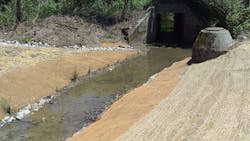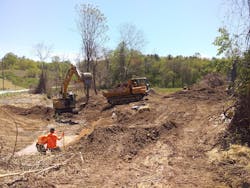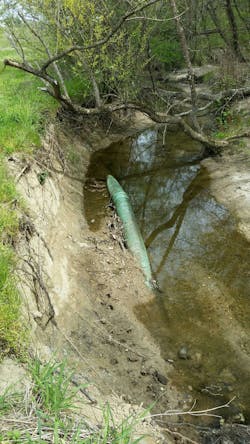Like many cities across the country, Hendersonville, NC, is grappling with how to protect its citizens and infrastructure from extreme weather. As a resident of North Carolina and in working with Environmental Defense Fund (EDF) to advocate for natural infrastructure as a solution to reduce community flood risk, I have a personal and professional perspective on this topic. Recently, the City of Hendersonville executed a restoration project to address water infrastructure challenges that provides a strong model for other municipalities in North Carolina and beyond to consider when confronting similar challenges.
Located in the western North Carolina mountains, the city of Hendersonville is home to about 14,000 residents and has a web of intersecting streams and sewer lines throughout its boundaries. The proximity of sewer lines, manholes, and related infrastructure to adjacent streambanks greatly increase the likelihood of pipelines failing due to erosion and sanitary sewer leakage reaching the waterway. In recent years, property owners have contacted city officials with greater frequency to report occurrences of streambank erosion impacting their property or posing a risk to sewer infrastructure.
Adding to these challenges, Western North Carolina is historically the wettest region in the state and 2015 to 2018 was the wettest period on record in this mountainous geography (Kunkel, et al. 2020). To confront these interrelated challenges, city officials pursued three key strategies: restoring streams to their natural condition, pursuing innovative funding opportunities, and engaging the public. Hendersonville’s three-pronged approach serves as a model for other municipalities seeking long term solutions that protect critical infrastructure and build resilience in the face of more intense precipitation events.
Turning to Nature for Long-Term ResilienceOften, public works departments rely on riprap, sandbags, or other structural solutions to shore up eroding streambanks. While these measures are relatively inexpensive, sandbags or riprap fail to address the underlying cause of erosion, which occurs when streams are unable to access their historic floodplains during rainfall events. Additionally, from a financial and staffing perspective, there are often unaccounted costs associated with quick fixes like riprap. Brent Detwiler, PE, City Engineer for the City of Hendersonville clarifies, “Riprap and sandbags are relatively inexpensive, but the largest cost is perhaps the time maintenance personnel spend on these temporary controls that take them away from their normal responsibilities.” Instead of commonly used quick fixes like riprap, staff in Hendersonville turned to nature to provide a long-term solution that would address the underlying cause of erosion while also providing ecological and aesthetic benefits.
Hendersonville’s Multi-Area Streambank Restoration Project (MASR) will restore 13,000 linear feet of stream, nearly 2.5 miles, to protect sewer infrastructure from erosion and to reduce the likelihood of sanitary flow reaching waterways. Stream restoration involves a mix of engineering, heavy equipment operation, and ecological design to return an impaired or eroding stream to its natural form. This work includes recontouring eroding stream banks to create broad, flat floodplains that slow and retain excess water during storms; using logs or boulders to create pools and flowing riffles to create diverse bedforms; and planting native vegetation to shade the stream and protect the soil. Yet the MASR is not solely an environmental project; Hendersonville staff selected stream restoration because it is the longest-lasting and most aesthetically pleasing way to protect infrastructure.
Local knowledge and leadership were also critical factors in ensuring that the city selected ecological methods instead of structural measures. City of Hendersonville’s Utilities Director, Lee Smith, had previous experience with stream restoration methods from his time living and working in eastern North Carolina and staff unfamiliar with stream restoration participated in the North Carolina State University Stream Restoration Program’s training workshops to better understand the advantages of ecological restoration. Detwiler comments, “The driver for the MASR was to protect sanitary sewer infrastructure that had been impacted by severe streambank erosion but given the City’s success utilizing natural bioengineered stabilization techniques on other projects we again favored stream restoration.” This local knowledge and leadership were buoyed by the support of the local US Army Corps of Engineers office in Asheville, who also favored natural stabilization methods instead of hardened measures.
Staff from Hendersonville had the preliminary engineering and permitting completed by Wildlands Engineering Inc. in April of 2019, opened construction bids in May 2019, and Baker Grading and Landscaping commenced construction in August 2019. Detwiler is pleased with Baker’s progress to date and anticipates project completion in November 2020. Once construction is complete, Hendersonville’s sewer and stormwater operations and maintenance staff will monitor the project to ensure site stabilization and lasting protection to infrastructure.
Leveraging Innovative Financing to Construct Lasting Solutions
Getting the Multi-Area Streambank Restoration Project constructed required officials to seek out creative funding opportunities. The North Carolina Division of Water Infrastructure (DWI) provides financial assistance, through a state revolving fund, for projects that improve water quality. A state revolving fund (SRF) is a source of funding that originates with state or federal money, which is then issued to borrowers in the form of a loan. As loans are repaid, the underlying fund grows, and income goes toward future loans. In North Carolina, the DWI receives grants from the EPA, which are administered statewide as a part of the Clean Water State Revolving Fund to address water quality needs.
The MASR was funded through DWI’s “green” funding program that provides 0% interest loans to municipalities that implement certain approved practices, including stream restoration. As a result, staff from Hendersonville were able to secure approximately $3 million from the DWI at a 0% interest rate. To repay the loan, Hendersonville will use revenue from its water and sewer enterprise fund. This combination of a 0% interest state loan and a dedicated water and sewer enterprise fund enabled Hendersonville to holistically address its infrastructure risk.
Working with the Public
Hendersonville’s MASR consists of over a dozen restoration sites, many of which were discovered and monitored by property owners. By encouraging the public to reach out to City officials before a catastrophic failure, the City is better able to plan for and implement long term solutions. Detwiler notes, “In the future, we hope to reach out to more of our citizens in order to assess and document bank erosion and to try to capture as many problematic areas as possible.”
An added benefit of this public engagement effort is that it helped to clarify just how much support there is in Hendersonville for using nature-based practices to protect infrastructure and property.
“The affected property owners along the MASR had been involved from the very beginning and were very much in favor of the stream stabilization work. However, once the project was underway and the general public was aware of it, we had several residents and business owners come forward to ask about the possibility of stream stabilization work on their own properties,” says Detwiler. This trusted partnership between City staff and residents has contributed to the success of the MASR, but it also positions Hendersonville to take on future restoration projects knowing that residents are supportive of these efforts.
Local governments across North Carolina and nationally continue to grapple with managing waterways and ensuring that infrastructure is protected from erosion and extreme rainfall events. Moreover, this responsibility is often an underfunded component of many public works departments. Compounding efforts to address risk is the financial uncertainty facing local budgets due to COVID and the resulting economic slowdown. Given these realities, ensuring that solutions to infrastructure risk are both long term and low maintenance is critical.
My work at EDF is focused on using natural infrastructure, like restored streams, to protect homes, businesses, roadways, and other traditional infrastructure from flooding and extreme weather. As precipitation events become more intense, we at EDF recognize the importance of building the resilience of critical infrastructure like water and wastewater to major rainfall events—and solutions like stream restoration can address that risk while also benefitting wildlife and water quality. The three-pronged approach of stream restoration, innovative funding, and public engagement that staff in Hendersonville pursued to protect their water infrastructure is a useful framework for other localities to adopt into their own solution set.
Acknowledgments
The author would like to thank Brent G. Detwiler, PE, City Engineer for the City of Hendersonville for his ongoing collaboration and for sharing detailed information on the Multi-Area Streambank Restoration Project. In addition, the author would like to thank Mark Hubbard, State Revolving Fund Grant Management Unit Supervisor with the North Carolina Division of Water Infrastructure for sharing details on its loan program and for connecting me with staff in Hendersonville.
Resources
Kunkel, K.E.; D.R. Easterling, A. Ballinger, S. Bililign, S.M. Champion, D.R. Corbett, K.D. Dello, J. Dissen, G.M., Lackmann, R.A. Luettich, Jr., L.B. Perry, W.A. Robinson, L.E. Stevens, B.C. Stewart, and A.J. Terando. North Carolina Climate Science Report. 2020. North Carolina Institute for Climate Studies. www.ncics.org/nccsr.
Stream Restoration Program, North Carolina State University Department of Biological and Agricultural Engineering. www.bae.ncsu.edu/extension/srp/.
North Carolina Environmental Quality, Division of Water Infrastructure. www.deq.nc.gov/about/divisions/water-infrastructure.
Feldmann, John and Vincent Gauthier; Maggie Monast; Mark Rupp; Britt Aasmundstad. Innovative State-Led Efforts to Finance Agricultural Conservation. Environmental Defence Fund and The National Association of State Departments of Agriculture. September 2019.








